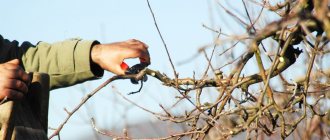Roses are beautiful, but they do not always delight even their adherents. For example, a flower garden or front garden attracts little attention if it is in a neglected, unkempt state. To keep rose bushes in good condition, scheduled pruning is carried out in spring, summer and autumn. You should be especially responsible when it comes to autumn pruning, since it is part of preparing plants for the winter dormant period. There are general recommendations for caring for all types of roses. But in addition to the generally accepted ones, there are individual rules for autumn pruning for each type of rose.
Should roses be pruned for the winter?
Autumn pruning of roses is carried out in order to prepare them for shelter, increase winter hardiness, provide shoots with access to light and strengthen plant immunity. The fact is that immature shoots left on a bush for the winter can rot under the covering material. To prevent this from happening, all immature, dry, damaged shoots that thicken the bush are removed in the fall (usually in the second half of October) from roses that need winter shelter and the remaining stems are shortened to the height of the covering material.
Both adult roses and seedlings planted this year are pruned for the winter. It must be remembered that the bushes cannot be pruned before night frosts begin, since any pruning stimulates the growth of shoots.
Winter-hardy flowers (for example, wrinkled rose hybrids) overwinter well without shelter, so they are not pruned for the winter.
Rosa wrinkled Alba does not need autumn pruning
Caring for bushes after pruning
How to mulch roses - which mulch is better
Autumn work on caring for rose bushes is not limited to pruning. These include:
- applying phosphorus-potassium fertilizers, which help the shoots to ripen;
- removing faded flowers;
- pinching young shoots;
- burning or adding to compost the green mass left after cutting plants;
- processing of cuts with garden varnish or a specialized paste;
- removing leaves before constructing a shelter to prevent the appearance of rot.
Rose is one of the most beautiful garden plants. To help it adequately withstand the tests of frost in winter, it is important to properly cut off its shoots, as well as carry out other autumn care measures.
How to prune floribunda roses for the winter
Often floribunda roses are still blooming in mid-autumn. But if the cold weather has already arrived, then do not spare the flowers, cut them off and prepare the bushes for shelter.
- How to properly cover roses for the winter - the best options for winter shelter
It's time to cover your roses for the winter. Read the article about how to do this quickly and at minimal cost.
Options for autumn pruning of floribunda roses depend on what kind of bush you want to get next year. If you shorten the shoots too much, smaller but lush bushes will grow, evenly strewn with flowers. With light pruning (if you cut off only a small part of the stem under the inflorescences), a tall and slender bush with a large number of flowers only in its upper part will bloom next season.
Tools and materials for pruning roses
Ideally, it is better to disinfect a sharp pruner in any convenient way, both before the procedure and after each bush. By acting in such a long way, you can be sure that the transmission of the disease from bush to bush is excluded.
The secateurs are very convenient to work with
A hacksaw copes with thick shoots
What to do after?
It is recommended to treat the plant after all of the above procedures. The choice of product depends on the climate. There are two options:
- in cold weather (below +5), iron-containing preparations are used;
- at temperatures above +6 - copper-containing substances.
Important! Iron sulfate at warm temperatures can burn the bushes, and copper preparation at low temperatures will be useless.
After all the procedures, all that remains is to wrap the bushes, which will provide favorable conditions during winter “hibernation”.
When is the best time to do this?
Roses should be pruned in the fall during the onset of the first night frosts, that is, when the temperature drops below zero only at night. You should not delay pruning until stable frosts appear, when temperatures are consistently below zero day and night.
As a rule, activities for pruning plant branches are carried out from mid-October to early November. To do this, the appropriate instruments are first sharpened and disinfected. However, more precise dates will depend on the climatic conditions of the region where the flower grows.
Important! It is recommended to prune adult plants and young seedlings planted in spring in the fall.
Timing of autumn pruning
It takes time for the plant to enter a state of dormancy, which slows down all life processes. Typically, this period begins when the temperature outside is above five degrees during the day and below zero at night.
Roses are grown in different climatic zones, so it is difficult to determine universal timing for pruning plants. The start time of the procedure depends on weather conditions.
Of course, it is easiest for residents of the southern regions to grow flower crops. There the climate is mild, and frosts, destructive for fastidious plants, are rare. Therefore, pruning can be done in November, but covering it is completely pointless. It is enough to sprinkle the base with sawdust to insulate the roots.
In the Middle Zone and the North-West, branches should be removed from the second half of October (from about October 15), in warm and dry weather.
Residents of the Urals and Siberia should begin work at the end of September. With the arrival of October cold, the bushes should already be insulated and covered.
Advice for beginners! It is very important to pay close attention to the timing of “sanitary cleaning” of bushes. After all, if you start work too early, the shoots will begin to grow, and this will lead to weakening of the plant and even to its death.
What to prepare in advance?
To speed up work and increase productivity, you need to prepare. Suitable tools and clothing will make the job easier.
Thick, durable gloves, thick garden trousers, and a long-sleeved jacket will provide good protection for your hands and feet from thorns.
When pruning roses, you must wear protective equipment and use special gardening tools.
A sharp pruner or scissors is suitable for this work.
Important! Transferring an infection from one branch to another is a common problem. Experienced gardeners recommend disinfecting tools with a solution of potassium permanganate or phytosporin. You just need to periodically dip the pruning shears in the liquid and continue working.
The cut areas are usually treated with garden pitch, coal or putty. This way the plant will not be afraid of fungus, insects and pests.
Adjust the feeding regime
How well roses will withstand winter temperatures depends on the maturity of the shoots. Naturally, young branches will die in severe frosts, so there is no point in stimulating their growth at the end of the season.
Stop applying nitrogen fertilizers in August. At the end of the season, roses need potassium-phosphorus feeding, which will strengthen the root system of the plant.
You can tell if roses are ready for winter by looking at the color of the branches. The red tint of the shoots indicates active growth. Ripened shoots turn green.
Temperature
The most appropriate time for sheltering is when the cold weather has already persisted constantly (at least 5-7 days), and according to weather forecasters, no warming is expected in the near future. The soil should freeze slightly, form a hard crust, and not thaw even in the daytime under the sun's rays.
If the thermometer stays stably around -2...-4 °C during the day, and drops to -5...-6 °C at night, then it’s time to insulate the roses. Even cold temperatures down to -15 °C are not scary for uncovered bushes, so there is no need to rush too much. The main thing is that the frosts are not too long.
Much more dangerous are sudden temperature changes, when during daylight hours the sun still warms well, but with the onset of darkness it seriously freezes. Prematurely covered plants confuse the seasons and begin a new growing cycle.
Many modern varietal and hybrid forms of roses cannot themselves determine when it is time for them to fall asleep, going into a state of winter dormancy. The gardener’s task is to help the bushes stop in time, stop developing and flowering, and also go to bed safely.
Bend the shoots of climbing roses
For the winter, the stems of climbing roses must be moved to a horizontal position. Even if in recent years they have overwintered vertically, without shelter, you are still taking a risk by leaving them on a support.
If the shoots are thick, there is a chance that they will break. Such plants bend down gradually over several weeks. Every week, lower the shoot lower, fixing it until it touches the ground.
Even without further shelter, the likelihood that a rose will overwinter well under the snow is much higher than in the open frost and harsh February sun.
Do not place shoots on bare ground. When the snow melts, the plant may rot. Use wooden boards or a piece of foam as a layer.
Preparation for the procedure
Immediately before carrying out rose pruning activities, you should prepare special tools:
- sharpened garden pruning shears for cutting branches. A blunt instrument can damage the plant bark by creating a ragged cut. Such cuts do not heal well and also become a source of infection;
- a hacksaw, which will be needed to remove old, rough branches;
- garden varnish, which is required for processing cuts. It allows you to protect the resulting wound from the penetration of bacteria and infections.
To prevent the flower from becoming infected with fungi and infectious diseases, it is recommended to disinfect all tools used by soaking them in a solution of potassium permanganate.
When and how to remove shelter in spring
With the onset of warm spring days, rose bushes should gradually begin to open. Since plants under film and roofing felt may begin to rot in warm weather, they need to be opened slightly to reduce the temperature under the shelter and improve ventilation. You cannot immediately remove the non-woven material, since the ground is still frozen and the lashes may turn black and die.
As you can see, preparing roses in the garden for winter, pruning and covering is a responsible task. Even if your area doesn't experience severe winter frosts, your rose bushes may get wet. Be sure to cover heat-loving varieties and then they will thank you with gorgeous blooms next year. Have beautiful rosaries!
Security measures
When pruning a bush rose before winter, certain safety precautions must be observed:
- carry out all work wearing thick gloves so as not to injure your hands with sharp thorns;
- prune the crop on a dry day without precipitation, since with high humidity, damage to the stems heals worse;
- immediately after the procedure, treat the cuts with wood ash, brilliant green or garden varnish - in this case, infections and viruses will not penetrate into the plant tissue.
A week after cutting, it is also recommended to perform a preventive spraying of the crop with copper sulfate or Bordeaux mixture. A plant that has been pruned is especially vulnerable to pests and fungi, and the likelihood of infection should be minimized.
How to treat diseases in the fall
In the fall, after flowering, the bushes are fed with potassium, calcium and phosphorus. Nitrogen-containing fertilizers are not used at this time of year, otherwise new shoots will begin to appear on the plants, which will negatively affect wintering.
You may be interested to know: what to feed the rose garden in August and September.
In preparation for winter, before covering, roses are treated with fungicidal preparations that will protect the plants from many diseases. The following fungicides are recommended:
- Fitosporin-M (the solution is prepared and used according to the instructions attached to it);
- 5% solution of iron sulfate.
Plants are watered very rarely in September and only if there is no precipitation.
Attention! It is not recommended to trim or cut flowers on rose bushes in the fall before sheltering, while it is still warm. This procedure stimulates the formation of new shoots.
Rose varieties for pruning
How different the varieties are, the different the approach to them. It is unacceptable to cut all shoots at the same height, since they have different requirements for wintering, shelter, and different winter hardiness. Some varieties do not cut off shoots, since buds form only on last year's stems.
Climbing grandiflora
Large-flowered varieties of climbing roses also need to be prepared for winter, but only with long pruning. Since the stems are extremely thick, they are cut down with a hacksaw and treated with garden varnish. The bush is spudded and covered with spruce branches or air-permeable material. It is impossible to bend a large-flowered climbing plant to the ground, and since the buds form on fresh shoots, long pruning contributes to the appearance of numerous vines in the spring.
The climbing large-flowered rose is a truly delightful addition to the garden!
Hybrid tea
Hybrid tea varieties are pruned by half or a little lower if the summer was warm and the bushes grew very strong and tall. The main thing to remember is that you need to retreat 0.5 cm from the outer bud.
Such preparation of these varieties for the winter will prevent the shoots from freezing, and it will become much more convenient to cover the bushes.
Lush flowering of hybrid tea varieties cannot be achieved without pruning before winter.
Floribunda
Floribunda is pruned according to the same principle as hybrid tea varieties: half a centimeter from the bud facing the outside of the bush and using the medium pruning method.
Beautiful Floribunda
Rambler climbing rose
Pruning climbing roses for the winter seems like a nightmare to a novice gardener. But we hasten to please you: from such a rose, the faded buds and formed fruits are simply removed. Then the lashes are removed from the support and laid, fixing the stems on the ground or on a layer of spruce branches. From above, the entire bush is covered with either coniferous spruce branches or covering breathable material. Large-flowered climbing roses are not pruned for the winter, since new buds form on last year's vines.
Ramblers with thin vines are not pruned for winter, but the stems are pinned for preservation.
This type of rose is pruned in the fall after flowering to improve its health: old, diseased stems and three-year-old shoots are removed. The more two-year-old shoots that overwinter, the more and more magnificent the rambler will delight with its flowers.
Rose Modern Shrub
All immature shoots, leaves, thin twigs that thicken the bush must be trimmed. Stems that are more than 2 years old must also be cut into rings. Ideally, a good bush can consist of 4-8 strong shoots; this should be remembered when removing branches that have grown over the summer in the fall. Although, some gardeners do this in the spring, because there is always a chance of some stems freezing in winter. In this case, the remaining ones will be able to replace the shoots that died in the winter.
Shrub Modern in bloom
Ground cover
This beautiful variety of roses does not require pruning before winter; it will be enough to remove the flowers and fruits. If the winter is snowy, then there is no need to cover such bushes.
Groundcover beauty
Stambovaya
You have to tinker with the trunks, because heavy pruning will damage them, but even with the removal of immature shoots onto the ring, such a mini-tree may be in danger of freezing. All flowers and fruits must be removed in the fall.
A standard rose is demanding of care. If a standard rose is planted in the fall, then pruning is carried out in the spring.
Park roses
Park roses themselves, like residents of large city parks, do not require such careful preparation for cold winter times as cutting off branches. But it is better to remove the fruits and faded buds, and very carefully. Also, do not leave any weak or immature stems to overwinter.
If some leaves linger on the bush, then they also need to be removed. But all healthy shoots, which are already lignified, as a rule, are left untouched. The exception is branches that thicken the crown of the bush. But they can be removed in the spring. If the variety is one-time flowering, then unripe shoots can simply be pinched out in the fall.
The park rose is grandiose and unpretentious
Polyantha roses
For polyanthus roses, pruning is done not before winter, but after it. In the spring, they remove everything that did not survive the frost, cutting the stems by a third and trying to leave the center of the bush free. In autumn, dead branches and those that thicken the bush are removed. At the end of October, only inflorescences and damaged branches are removed.
Polyantha queen of the garden
Winter hardiness and frost resistance - terms
Winter hardiness is the ability of plants to withstand a complex of environmental influences during the winter and early spring periods. This includes the ability to withstand spring burns, low temperatures, damping off, soaking, and the ability to withstand frequent temperature changes.
Frost resistance is only the ability of a plant to tolerate low temperatures.
Winter-hardy varieties, in turn, are divided into:
- Absolutely winter-hardy , for example Blanc Double de Coubert, William Baffin, Charles Albanel. These roses tolerate cold well in an upright position. During this time, the flowers do not freeze.
- Hardy : Agnes, Morden Fireglow, Morden Ruby, Prairie Princess, Robusta White, Grootendorst, Winnipeg Parks. They overwinter vertically, but in severe winters freezing is possible.
- Moderately winter-hardy : Reine des Violettes, Rugelda, Sir Henry, Stanwell, Perpetual Prairie Lass, Prairie Squire, Prairie Star. Before leaving for the winter, you need to bend the branches to the ground and cover them with material. If you do not cover, the roses may freeze.
Sheltering standard roses: instructions with video
How to cover standard roses for the winter depends on the age of the plants:
- Do not bend down mature bushes with woody stems, as the branches will break. To insulate them, you can simply wrap the bushes with roofing felt. However, it is best to build a wire frame over the plants over which the film is stretched. As a result, the shelter should look like a hut. The inside of the plants is insulated with dry sawdust, leaves or pine needles. To keep the film in place, it is tied to the frame with a rope or the edges are secured with stones.
- Young plants need to be carefully bent to the ground, on which the spruce branches are previously laid. The shoots should be attached with pins and covered with spruce branches on top. The base of the bush is covered with a thick layer of sand or covered with leaves. On top, young standard roses are covered with roofing felt, roofing felt or film.
Watch a video about covering standard roses for the winter.











